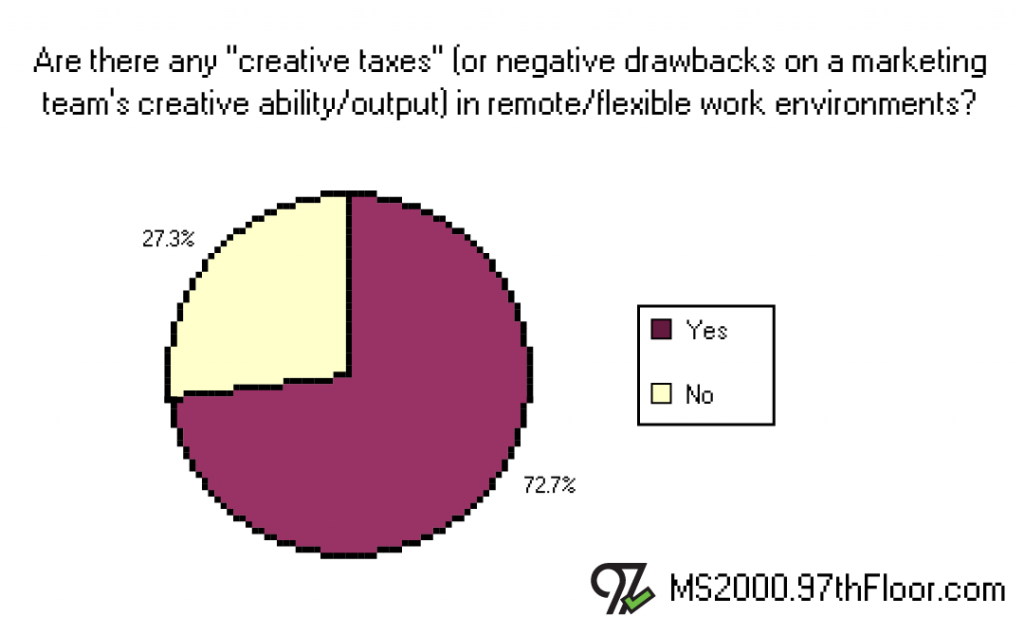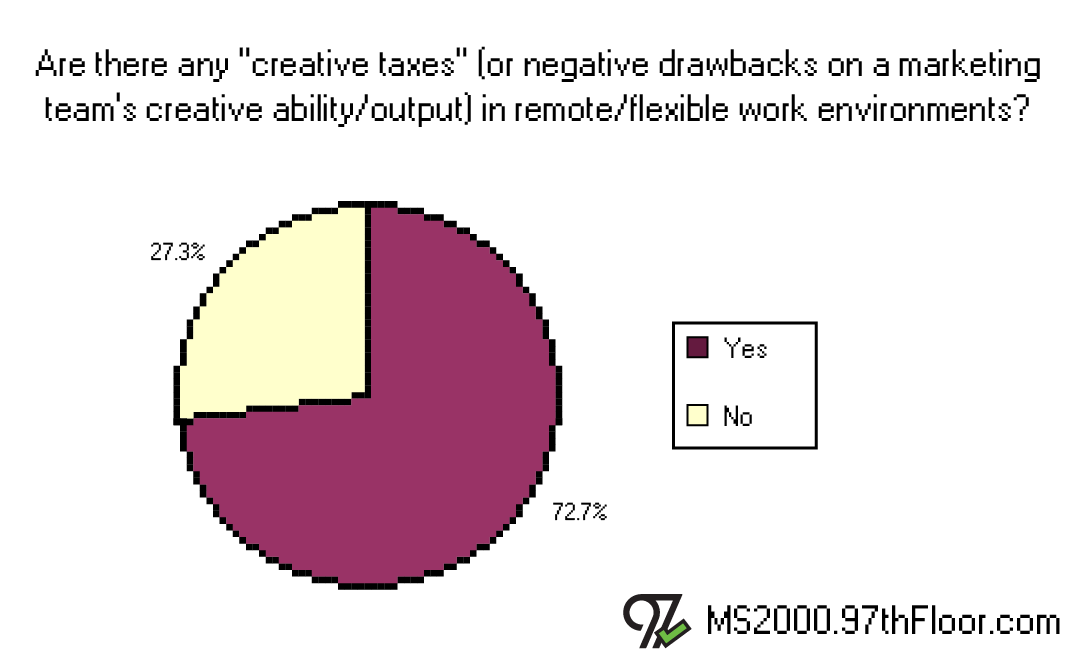No doubt, there are many benefits from the increase in remote/flexible work. But do we fully recognize and address the “creative taxes” that follow suit? A strong majority of respondents acknowledge that there are “creative taxes” to this shift in the workplace. See below for a list of our respondents’ “creative taxes”:

What “creative taxes” come with flexible/WFH work environments?
You can read respondents’ specific answers below. Overall, responses centered on three core “creative taxes” from flexible/WFH work environments:
- Remote brainstorming and “riffing” just doesn’t match in-person brainstorming.
- Overall collaboration and speed-to-execution is reduced.
- The ability to connect with and energize other team members is strained.
| When the only way you interact with your team is in a scheduled meeting—you want those meetings to be really organized, have agendas, etc. That’s how productive meetings should be run. But that “ultra-productive” environment isn’t conducive to organic brainstorming, learning and interacting. – Senior-Level Marketer in B2B |
| Creative brainstorm sessions can be done remotely, but often they’re most effective when you have everyone in the same room. – Senior-Level Marketer in B2B |
| Virtual brainstorming and storyboarding is never as good as virtual. – Senior-Level Marketer in B2B |
| Mostly positives [from WFH], but the major negative of “distractivity.” Creativity requires deep thinking that can be interrupted by home life. – Manager-Level Marketer in Non-Profit |
| Quick iterating and describing desired changes. – Senior-Level Marketer in B2C |
| No access to unprovoked conversations or feedback gathering from within or outside your department. In other words, WFH disenfranchises, “Hey, would you mind looking at this and telling me what you think?” conversations. – Senior-Level Marketer in B2B |
| More difficult to idea share, collaborate on truly creative solutions (not just production grade). – Senior-Level Marketer in B2B |
| Energy, Connection. – Senior-Level Marketer in B2B |
| Same setup for home as in office. – Manager-Level Marketer in B2B |
| Quick iterations. Passive listening and contributing. – Senior-Level Marketer in B2C |
| Reading each other’s body language, energy from being in the room together. – Senior-Level Marketer in B2B |
| In-person collaboration has simply been more effective for creative strategy – using the zoom whiteboard isn’t nearly as effective as pacing the room, scribbling on the whiteboard, etc. Another big disadvantage is that people pipe up less because it’s harder to be heard when you’re always worried about talking over someone due to delays or connections. (We are all remote anyway, but I have noticed this sacrifice). – Senior-Level Marketer in B2B |
| It’s harder to collaborate. – Senior-Level Marketer in B2B |
| Collaboration, connection. – Manager-Level Marketer in B2B |
| I’d say there are taxes like loss in team unity and brainstorming, but these can be overcome. You just need to address them. – Manager-Level Marketer in B2C |
| Less rapid collaboration. – Manager-Level Marketer in B2B |
| There’s an overall drop in ‘spontaneous combustion between creatives,’ i.e., impromptu brainstorming that happens in hallways, between cubicles, and at water coolers. – Senior-Level Marketer in Non-Profit |
| Less social capital between team members, which contributes to lower collaboration. – Manager-Level Marketer in B2C |
| Delays in feedback, loss of real-time iteration. – Senior-Level Marketer in B2B |
| Lack of collaboration. – Senior-Level Marketer in B2B |
| More in depth collaborations and ability to “riff” better with brainstorming activities. – Senior-Level Marketer in B2B |
| Honest collaboration. – Manager-Level Marketer in B2B |
| Lack of face time. – Senior-Level Marketer in B2B |
| It isn’t as easy to brainstorm or share ideas. also it doesn’t foster cross-team communication. – Senior-Level Marketer in B2C |
| More likelihood of miscommunications, negative strain on culture and collaboration. – Senior-Level Marketer in B2C |

